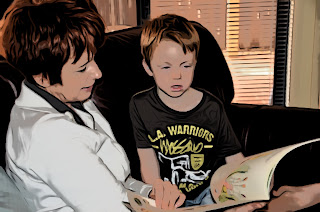One way to develop fluency is to look for words within words.. For example, the word 'updated' has 'date' as its base word with the 'up-' as a prefix and 'ed' as a suffix. The word 'updated' can be made easier to read when the word within-the-word (date) is recognised automatically and the affixes are tacked on.
The more information that readers have to process the slower the reading will become and the less fluent it will sound. However, reading is made easier when information is processed in larger chunks. The larger the chunk the more efficient the reading will become.
Good readers look for cues while they are reading. They sample the text for the best cues that will enable them to work out the word by touching the fewest possible bases. Α good reader may apply a number of sampling strategies. They may predict words by sampling the first letter and/or consider the overall shape of the word to confirm to correct their predictions. Sometimes they will see a word within a word and recognise it automatically. This process minimises the amount of information that needs to be processed and enables fluent reading to take place.
One useful method to help children do this is to use the 'L' plates or two 'L' shapes pieces of plastic to focus attention on a word within a word. Often, the other letters in the word will interfere with the identification of the root word so this masking technique is used initially to enable focal attention. To make the 'L' plates take an ice-cream container lid and cut out two small 'L' shapes. Invert one of the 'L's to form a rectangle so that they can be adjusted in relation to one another to fit neatly around the root word and mask the affixes. In the example below the word 'flapping' was masked to show the root word 'flap'.
Initially, this process should be modelled by the adult. The child should then use it to do the same independently. Eventually there will be no need to keep using the 'L' plates and the reader will recognise the root words automatically.
The more information that readers have to process the slower the reading will become and the less fluent it will sound. However, reading is made easier when information is processed in larger chunks. The larger the chunk the more efficient the reading will become.
Good readers look for cues while they are reading. They sample the text for the best cues that will enable them to work out the word by touching the fewest possible bases. Α good reader may apply a number of sampling strategies. They may predict words by sampling the first letter and/or consider the overall shape of the word to confirm to correct their predictions. Sometimes they will see a word within a word and recognise it automatically. This process minimises the amount of information that needs to be processed and enables fluent reading to take place.
One useful method to help children do this is to use the 'L' plates or two 'L' shapes pieces of plastic to focus attention on a word within a word. Often, the other letters in the word will interfere with the identification of the root word so this masking technique is used initially to enable focal attention. To make the 'L' plates take an ice-cream container lid and cut out two small 'L' shapes. Invert one of the 'L's to form a rectangle so that they can be adjusted in relation to one another to fit neatly around the root word and mask the affixes. In the example below the word 'flapping' was masked to show the root word 'flap'.
Initially, this process should be modelled by the adult. The child should then use it to do the same independently. Eventually there will be no need to keep using the 'L' plates and the reader will recognise the root words automatically.






